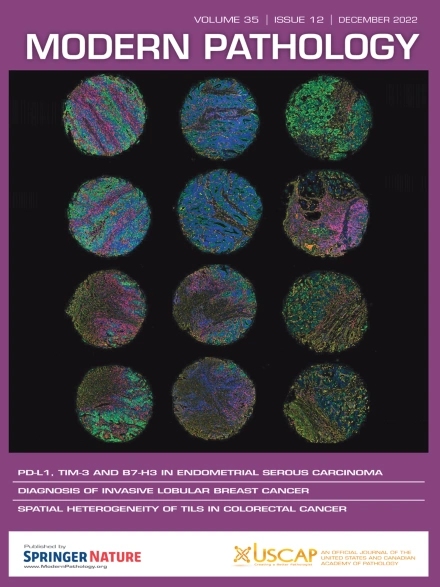浅表神经嵴FET::ETS融合瘤:扩展新近描述实体的临床病理学和分子遗传学谱系。
IF 7.1
1区 医学
Q1 PATHOLOGY
引用次数: 0
摘要
表皮神经肉瘤 EWSR1::FLI1 融合瘤是一种最近才被描述的、临床上不太活跃的皮肤和表皮软组织肿瘤,尽管它与尤文肉瘤有相同的融合基因,但在所有方面都与尤文肉瘤不同。EWSR1和FLI1基因分别是FET和ETS基因家族的成员,极少数尤文肉瘤携带替代的FET::ETS融合事件,如EWSR1::ERG、FUS::FLI1、FUS::ERG、EWSR1::ETV4等。我们报告了5例这种非常罕见的新病例,其中3例携带替代性FET::ETS融合事件。这些肿瘤分别发生在 2 名男性和 3 名女性身上(中位年龄 14 岁;范围 8-69 岁),表现为大腿、足部、肩部、手臂和背部的真皮/皮下单发肿块(中位尺寸 1.8 厘米;范围:1-2 厘米)。所有患者均接受了广泛切除术,其中一人接受了辅助化疗。对 3 名患者的临床随访(中位数:24 个月;范围:18-31 个月)显示,所有患者均无疾病。从形态学上看,所有肿瘤都显示出上述实体瘤的典型特征,即细胞学上无斑点、弥漫性 S100 蛋白/SOX10 阳性、无有丝分裂活动的圆形细胞巢,周围是含有具有类似核特征的纺锤形细胞的纤维带。肿瘤还显示膜CD99(4/5)和核NKX2.2(3/3)表达。RNA测序(4例)显示FUS::FLI1、FUS::ERG、EWSR1::FLI1、EWSR1::ERG和新型FUS::ETV5。甲基化分析(4 个病例)显示,所有病例都与之前报道的浅表神经肉瘤 EWSR1::FLI1 融合肿瘤聚集在一起,与传统的和 "金刚瘤样 "尤文肉瘤不同。我们的研究结果证实了这种非常罕见、最近才被描述的实体肿瘤的独特临床病理特征,并扩大了其分子遗传谱。为了反映这些发现,我们建议将这一实体的名称改为 "浅表神经克里斯蒂FET::ETS融合瘤"。本文章由计算机程序翻译,如有差异,请以英文原文为准。
Superficial Neurocristic FET::ETS Fusion Tumor: Expanding the Clinicopathological and Molecular Genetic Spectrum of a Recently Described Entity
Superficial neurocristic EWSR1::FLI1 fusion tumor is a very recently described, clinically indolent tumor of the skin and superficial soft tissues, which differs in essentially all ways from Ewing sarcoma, despite harboring an identical fusion event. The EWSR1 and FLI1 genes are members of the FET and ETS gene family, respectively, and very rare examples of Ewing sarcoma harbor alternative FET::ETS fusion events, such as EWSR1::ERG, FUS::FLI1, FUS::ERG, EWSR1::ETV4, and others. We report 5 new cases of this very rare entity, harboring in 3 cases alternative FET::ETS fusion events. The tumors occurred in 2 males and 3 females (median age, 14 years, range, 8-69 years) and presented as solitary dermal/subcutaneous masses of the thigh, foot, shoulder, arm, and back (median size, 1.8 cm; range, 1-2 cm). All patients underwent wide excisions; one received adjuvant chemotherapy. Clinical follow-up on 3 patients (median, 24 months; range, 18-31 months) showed all to be without disease. Morphologically, all tumors displayed typical features of this entity as described, with nests of cytologically bland, diffusely S100 protein/SOX10-positive round cells without mitotic activity, surrounded by fibrous bands containing spindled cells with similar nuclear features. The tumors also showed membranous CD99 (4/5) and nuclear NKX2.2 (3/3) expression. RNA sequencing (5 cases) demonstrated FUS::FLI1, FUS::ERG, EWSR1::FLI1, EWSR1::ERG, and a novel FUS::ETV5. Methylation profiling (4 cases) showed all to cluster with previously reported superficial neurocristic EWSR1::FLI1 fusion tumors and apart from conventional and “adamantinoma-like” Ewing sarcoma. Our findings confirm the distinctive clinicopathological features of this very rare, recently described entity and expand its molecular genetic spectrum. Reflecting on these findings, we propose modifying the name of this entity to “superficial neurocristic FET::ETS fusion tumor.”
求助全文
通过发布文献求助,成功后即可免费获取论文全文。
去求助
来源期刊

Modern Pathology
医学-病理学
CiteScore
14.30
自引率
2.70%
发文量
174
审稿时长
18 days
期刊介绍:
Modern Pathology, an international journal under the ownership of The United States & Canadian Academy of Pathology (USCAP), serves as an authoritative platform for publishing top-tier clinical and translational research studies in pathology.
Original manuscripts are the primary focus of Modern Pathology, complemented by impactful editorials, reviews, and practice guidelines covering all facets of precision diagnostics in human pathology. The journal's scope includes advancements in molecular diagnostics and genomic classifications of diseases, breakthroughs in immune-oncology, computational science, applied bioinformatics, and digital pathology.
 求助内容:
求助内容: 应助结果提醒方式:
应助结果提醒方式:


